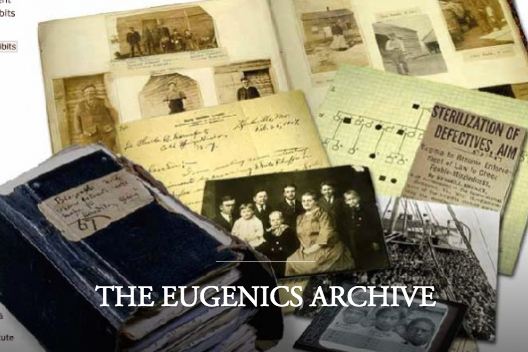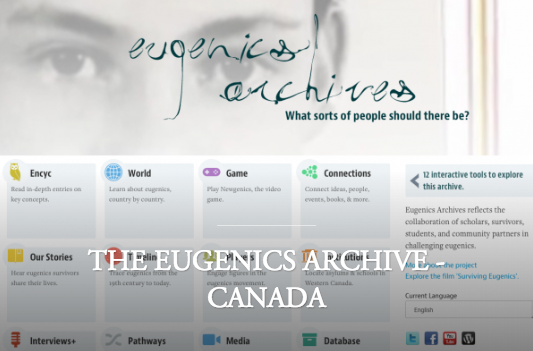
An Archive produced from collections held by
Cold Spring Harbor Laboratory in New York,
home of the Eugenics Record Office, 1910-1939

An amazing resource focused on the history of eugenics in
Western Canada and the contemporary significance of that history.
SCHOLARSHIP ON THE HISTORY OF EUGENICS
For more than a generation, scholars of the history of science have documented and debated the history of the American eugenics movement. Recently, universities are examining their own roles in the eugenics movement by opening up their archives (for an example, click HERE). Here is a list of some of important scholarship on the topic.
Allen, Garland E. “The Eugenics Record Office at Cold Spring Harbor, 1910-1940: An Essay in Institutional History.” Osiris 2(1986): 225–64.
Brave, Ralph, and Kathryn Silva. “Exhibiting Eugenics: Response and Resistance to a Hidden History.” The Public Historian 29(2007): 33–51.
Burke, Chloe S., and Christopher J. Castenada. “The Public and Private History of Eugenics: An Introduction.” The Public Historian 29(2007): 5–17.
Comfort, Nathaniel. 2006. “‘Polyhybrid heterogeneous bastards’: promoting medical genetics in America in the 1930s and 1940s.” Journal of the history of medicine and allied sciences 61: 415- 455.
____. 2012. The Science of Human Perfection: How Genes Became the Heart of American Medicine. (Yale University Press).
____. 2015. “A new eugenics.” Nation 301: 27-32.
Cot, Annie L. “‘Breed out the Unfit and Breed in the Fit’: Irving Fisher, Economics, and the Science of Heredity.” The American Journal of Economics and Sociology 64(2005): 793–826.
Dorr, Gregory Michael. 2000. “Assuring America’s place in the sun: Ivey Foreman Lewis and the teaching of eugenics at the University of Virginia, 1915-1953.” The Journal of Southern History 66: 257-296.
Dyck, Erika. 2014. “Sterilization and Birth Control in the Shadow of Eugenics: Married, Middle-Class Women in Alberta, 1930–1960s.” Canadian Bulletin of Medical History 31: 165- 187.
Dyck, Erika and Maureen Lux. 2016. “Population Control in the ‘Global North’?: Canada’s Response to Indigenous Reproductive Rights and Neo-Eugenics.” Canadian Historical Review 97: 481-512.
Farber, Paul. Mixing Races: from Scientific Racism to Modern Evolutionary Ideas (Johns Hopkins University Press, 2010).
Glenna, Leland L., Margaret A. Gollnich and Stephen S. Jones. 2007. “Eugenic Opportunity Structures: Teaching Genetic Engineering at US Land-Grant Universities since 1911,” Social Studies of Science 37: 281-296.
Kevles, Daniel J. 1995. In the name of eugenics: Genetics and the uses of human heredity. No. 95. Harvard University Press.
Kimmelman, Barbara A. 1983. “The American Breeders’ Association: genetics and eugenics in an agricultural context, 1903-13.” Social studies of science 13: 163-204.
Kimmelman, Barbara A. “The American Breeders’ Association: Genetics and Eugenics in an Agricultural Context, 1903-13.” Social Studies of Science 13(1983): 163–204.
Ladd-Taylor, Molly. 1997. “Saving babies and sterilizing mothers: Eugenics and welfare politics in the interwar United States.” Social Politics: International Studies in Gender, State & Society 4: 136-153.
____. 2001. “Eugenics, sterilisation and modern marriage in the USA: The strange career of Paul Popenoe.” Gender & History 13: 298-327.
___. 2017. Fixing the Poor: Eugenic Sterilization and Child Welfare in the Twentieth Century (Johns Hopkins).
Largent, Mark A. Breeding Contempt: The History of Coerced Sterilization in the United States. (Rutgers University Press, 2011).
Larson, Edward J. Sex, Race, and Science: Eugenics in the Deep South (Baltimore: Johns Hopkins University Press, 1995).
Lombardo, Paul A. 2008. Three generations, no imbeciles: Eugenics, the Supreme Court, and Buck v. Bell. JHU Press.
Lombardo, Paul A., ed. 2011. A century of eugenics in America: from the Indiana experiment to the human genome era. Indiana University Press.
Lovett, Laura L. “‘Fitter Families for Future Firesides’: Florence Sherbon and Popular Eugenics.” The Public Historian 29(2007): 69–85.
Nurridin, Ayah. 2017. “The Black Politics of Eugenics,” Nursing Clio. June 1.
Paul, Diane. “Eugenics and the Left.” Journal of the History of Ideas 45(1984): 567–90.
____. 1998. The Politics of Heredity: Essays on Eugenics, Biomedicine, and the Nature-Nurture Debate SUNY Press.
____. 1995. Controlling Human Heredity: 1865 to the Present (Humanities Books).
____. 1997. “From eugenics to medical genetics.” Journal of Policy History 9: 96-116.
____. 2014. “What was wrong with eugenics? Conflicting narratives and disputed interpretations.” Science & Education 23: 259-271.
____. 2016. “Reflections on the historiography of American eugenics: Trends, fractures, tensions.” Journal of the History of Biology 49: 641-658.
Paul, Diane, Hamish G. Spencer and John Stenhouse, 2017. Eugenics at the Edges of Empire (Palgrave Macmillan).
Pauly, Philip J. 2002. Biologists and the Promise of American Life: from Meriwether Lewis to Alfred Kinsey (Princeton University Press).
Rosen, Christine. 2004. Preaching eugenics: Religious leaders and the American eugenics movement. Oxford University Press.
Stern, Alexandra Minna. 2005. “Sterilized in the name of public health: race, immigration, and reproductive control in modern California.” American Journal of Public Health 95: 1128- 1138.
____. 2016. Eugenic nation: Faults and frontiers of better breeding in modern America. Vol. 17. Univ of California Press.Woiak, Joanne. 2007. “Designing a brave new world: Eugenics, politics, and fiction.” The Public Historian 29: 105-129.
Historical Memory & Commemoration
Local and national discussions about renaming buildings and institutions are part of broader debates about the relationship between commemoration and historical memory. Institutional responses to these debates have varied: some have shied away from such conversations, others have embraced the challenge of developing complex and holistic plans for assessing naming and commemoration practices while wrestling with the complex legacies of the past. Some names have been changed; others have been kept. Below you can find blogs, scholarship, and news coverage (in chronological order) of debates taking place nationally and internationally regarding buildings and institutions named after eugenicists.
David Starr Jordan (1851-1931)~ Chancellor of Stanford University, influential biologist and one of the main popularizers of eugenics
October 27, 2018: Jordan Hall renaming discussed at PACE Event (Indian University)
April 23, 2019: Renaming of David Starr Jordan Middle School in Burbank (California)
Biologist C.C. Little (1888-1971) ~ University of Michigan biologist
April 17, 2016: Op-Ed: Questioning C.C. Little’s Legacy
March 29, 2018: University of Michigan to Remove Little, Winchell Names from Campus Facilities
Theodore Roosevelt (1859-1919) – U.S. President and conservationist
The American Museum of Natural History Museum’s Exhibit: Addressing the Statue
June 24, 2020: We don’t have to like them. We just need to understand them (The New York Times).
June 21, 2020: Roosevelt Statue to be removed from Museum of Natural History (The New York Times
June 27, 2020: Removing the Statue (TR and Others). Letters to The New York Times
June 28, 2020: Defenders of Roosevelt Statue converge on Natural History Museum (The New York Times)
Francis Galton (1922-1911) ~ Statistician who coined the term Eugenics
February 8, 2020: UCL Eugenics Inquiry did not go far enough, committee say (The Guardian)
June 29, 2020: UCL Renames Three Facilities that Honoured Prominent Eugenicists (The Guardian)
Paul Brandon Barringer (1857-1941) ~ Physician and eugenicist from the University of Virginia
Another UVa Building named after a Eugenicist could be Renamed